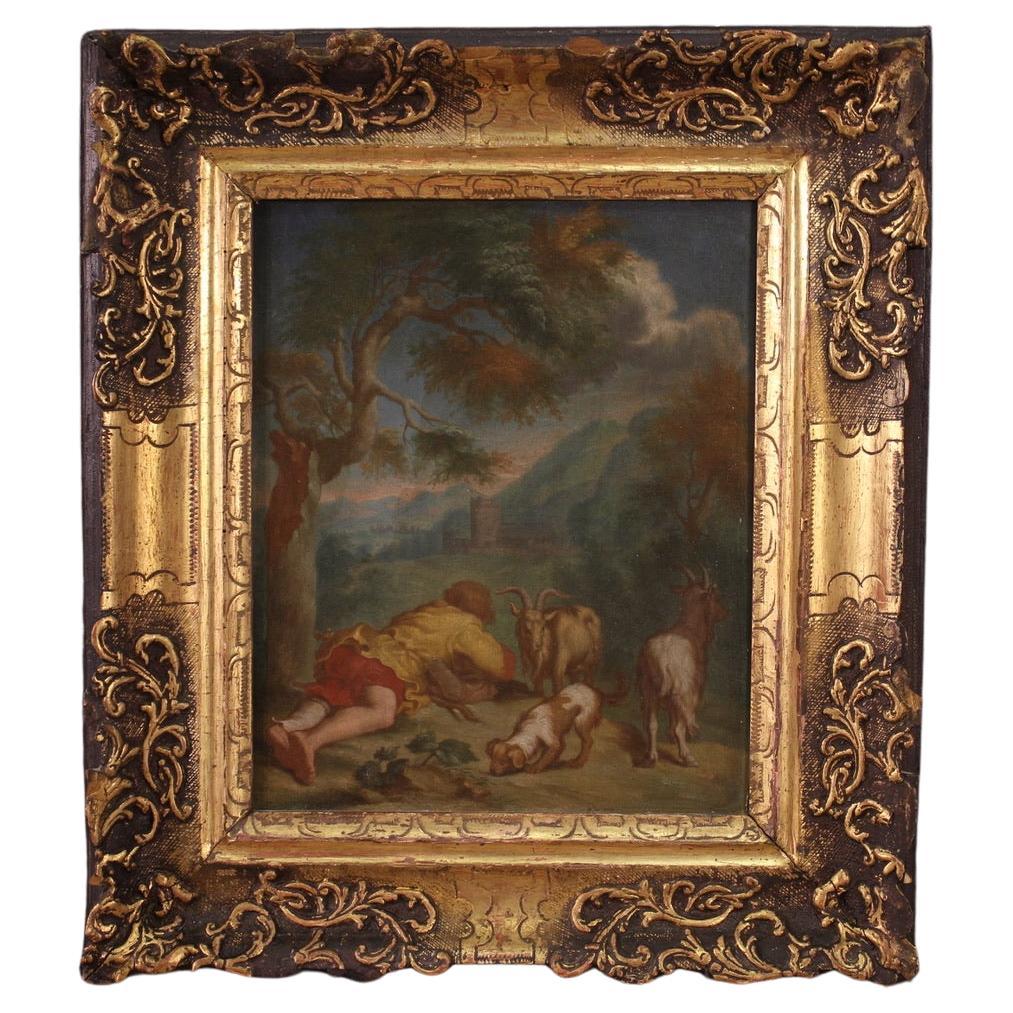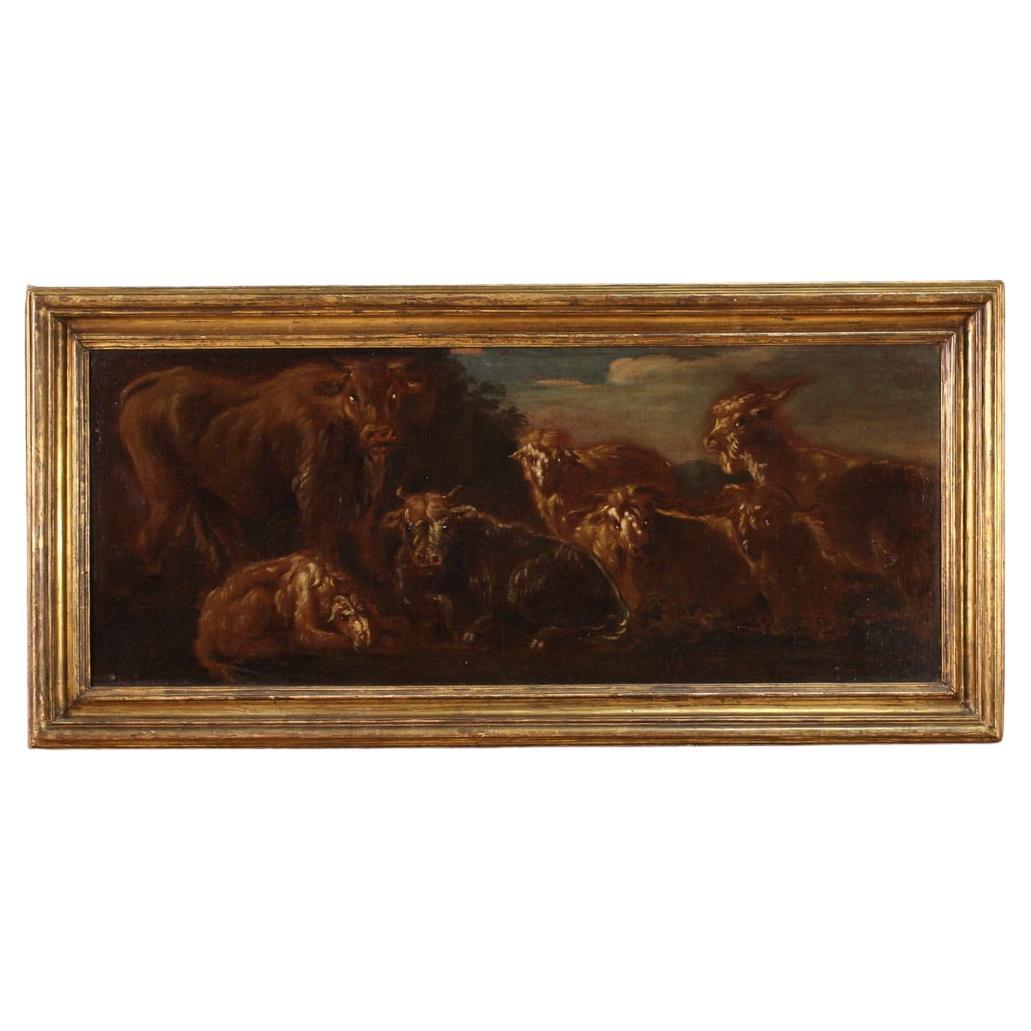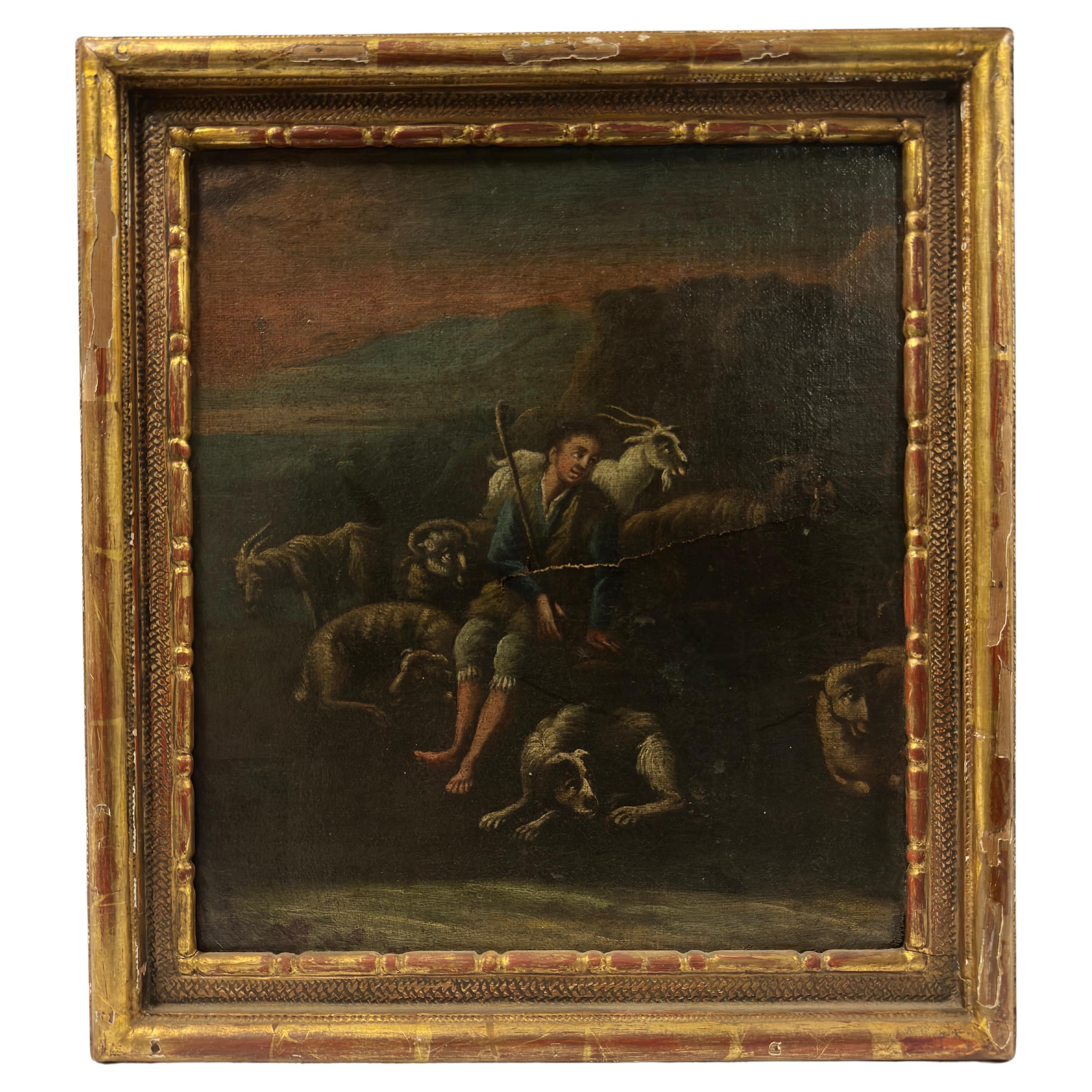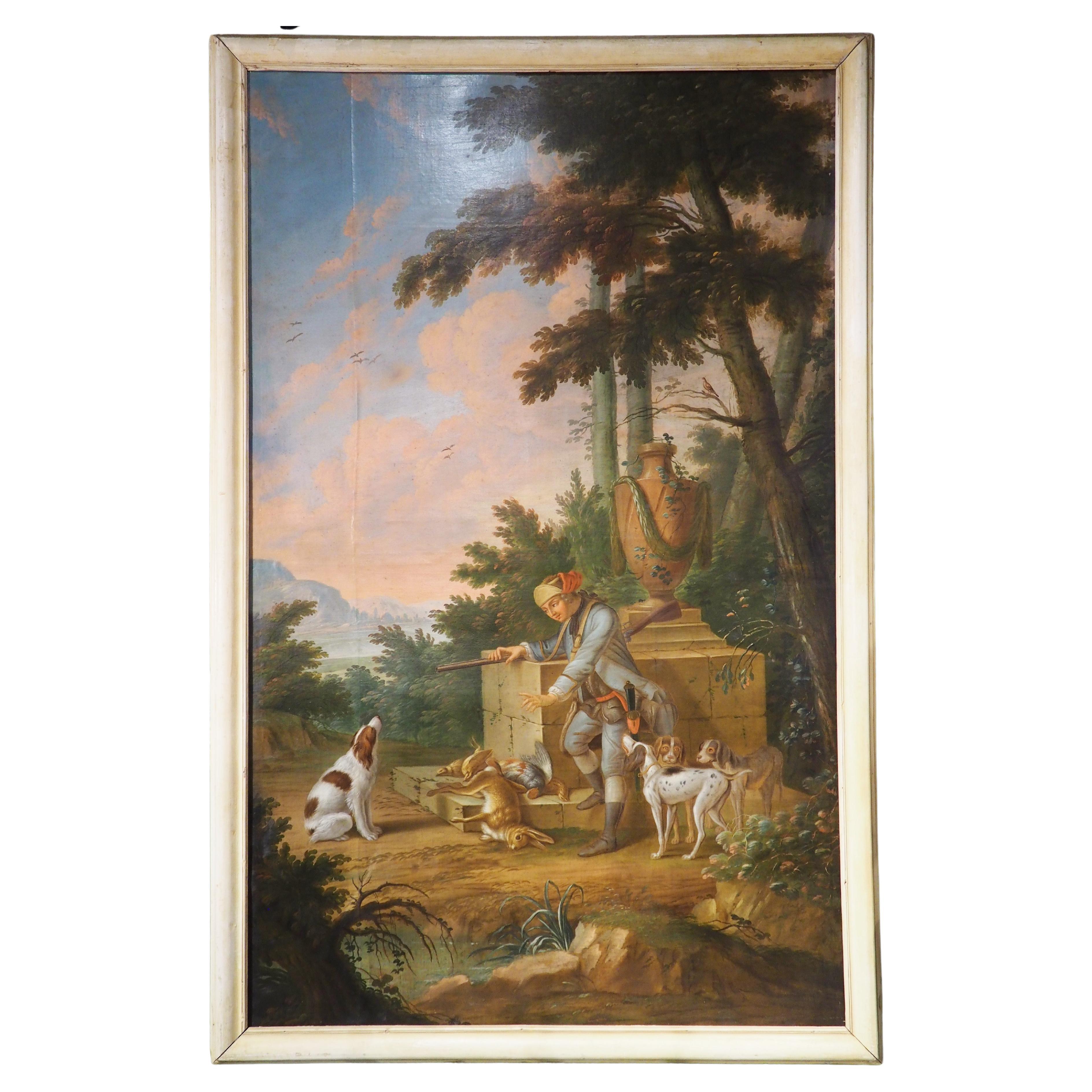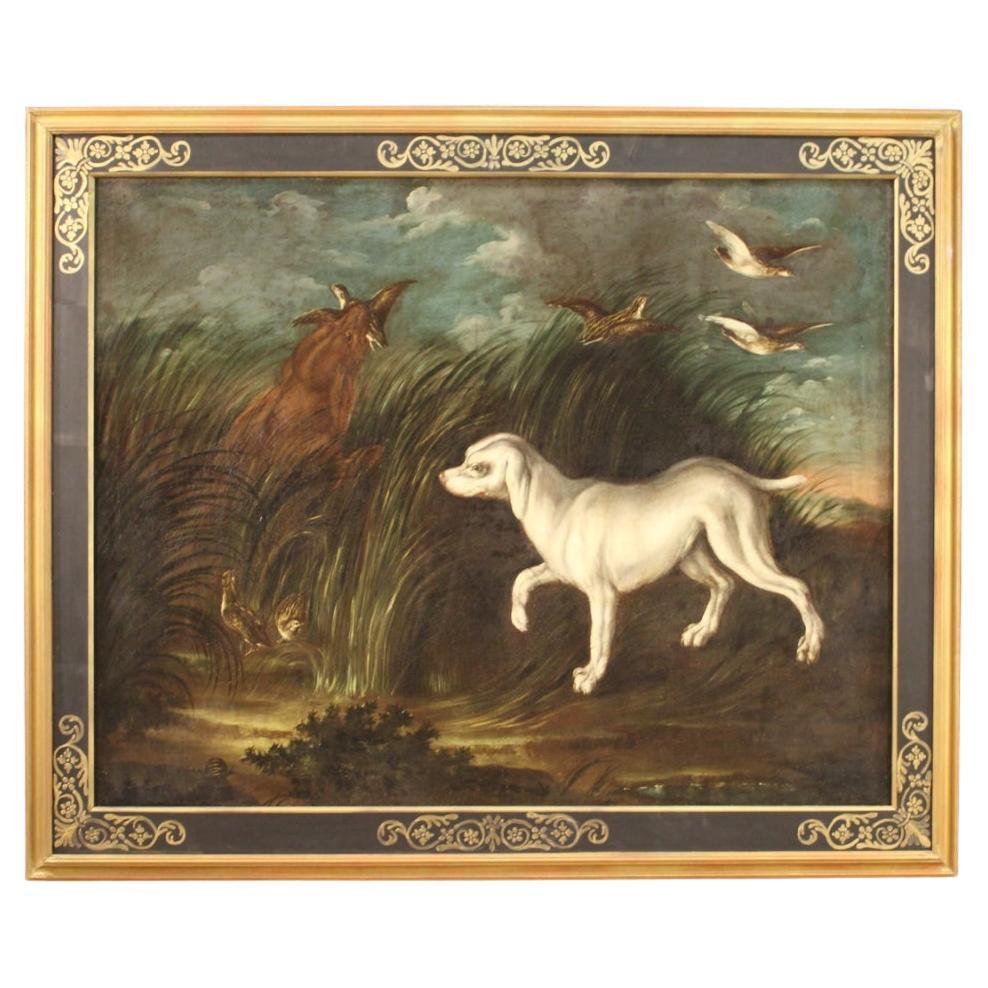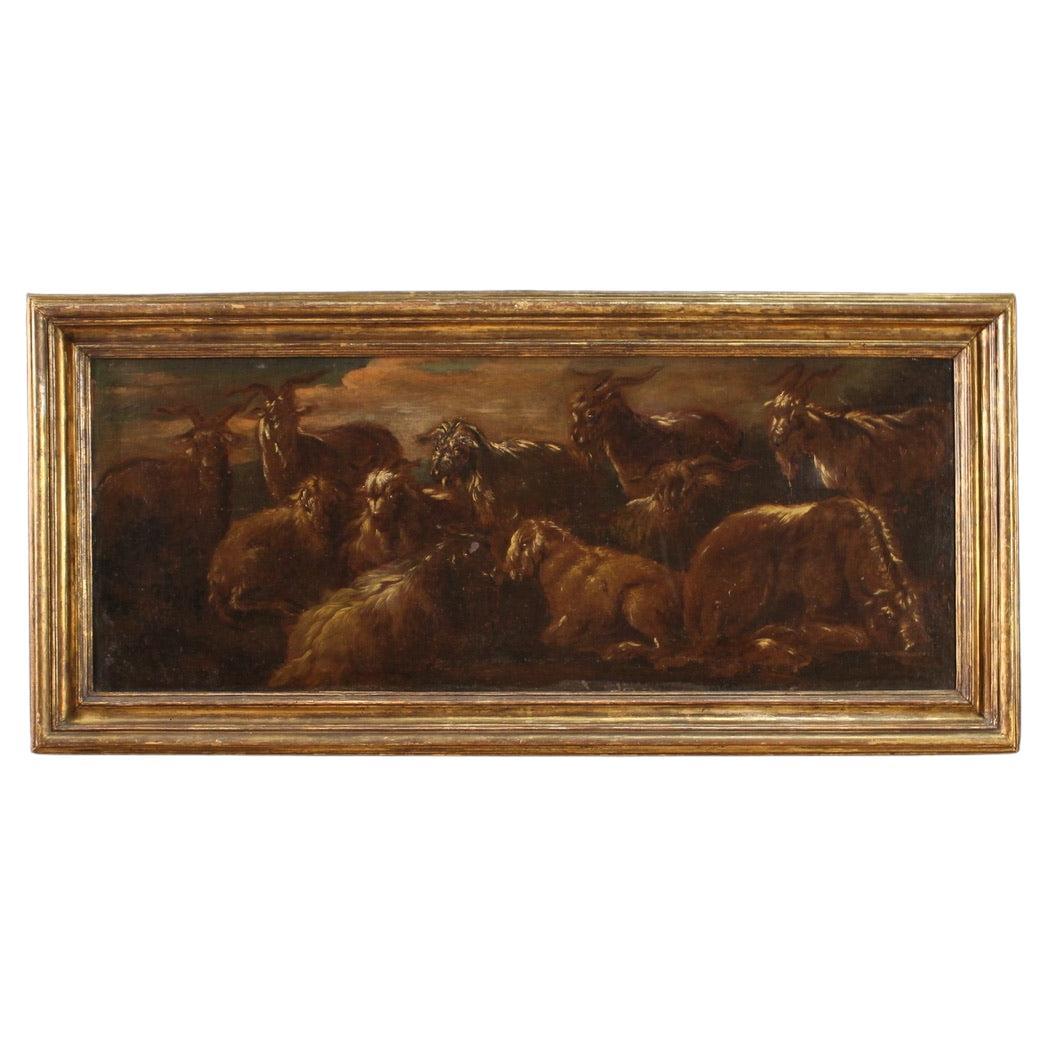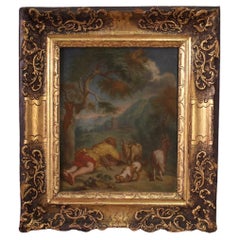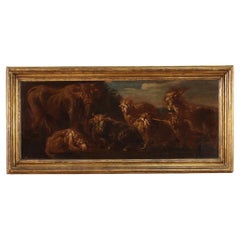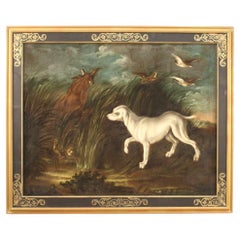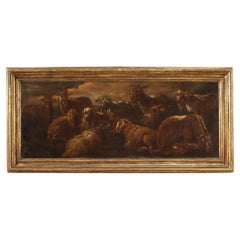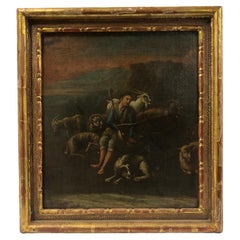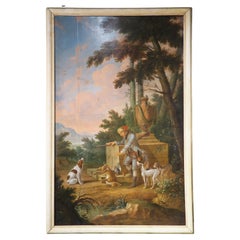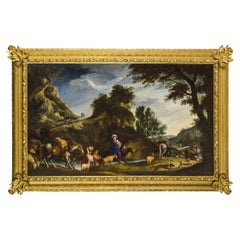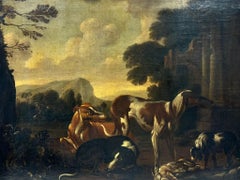Items Similar to 17th Century Oil on Canvas Antique Italian Painting Shepherd with his Dogs
Want more images or videos?
Request additional images or videos from the seller
1 of 15
17th Century Oil on Canvas Antique Italian Painting Shepherd with his Dogs
$8,738.94
£6,590.76
€7,500
CA$12,082.35
A$13,534.26
CHF 7,108.68
MX$164,572.27
NOK 90,019.14
SEK 85,452.37
DKK 57,094.91
About the Item
Antique Lombard painting of the 17th century. Oil painting on canvas of considerable size depicting a shepherd with his dogs immersed in a countryside landscape. Painting of great pictorial quality, the mastery with which the painter has represented the animals is remarkable. Non coeval frame in carved, lacquered and gilded wood, of beautiful decoration. Painting that has undergone a conservative restoration with relining, replacement of the frame and color recovery in some small points, overall in excellent state of conservation. Sight size H 71 x W 181 cm.
- Dimensions:Height: 36.62 in (93 cm)Width: 79.53 in (202 cm)Depth: 1.97 in (5 cm)
- Materials and Techniques:Canvas,Oiled
- Place of Origin:
- Period:
- Date of Manufacture:1660
- Condition:Repaired: Painting that has undergone a conservative restoration with relining, replacement of the frame and color recovery in some small points, overall in excellent state of conservation. Wear consistent with age and use. Painting that has undergone a conservative restoration with relining, replacement of the frame and color recovery in some small points, overall in excellent state of conservation.
- Seller Location:Vicoforte, IT
- Reference Number:Seller: 103431stDibs: LU1848345715862
About the Seller
5.0
Gold Seller
Premium sellers maintaining a 4.3+ rating and 24-hour response times
Established in 2004
1stDibs seller since 2016
215 sales on 1stDibs
Typical response time: <1 hour
- ShippingRetrieving quote...Shipping from: Vicoforte, Italy
- Return Policy
Authenticity Guarantee
In the unlikely event there’s an issue with an item’s authenticity, contact us within 1 year for a full refund. DetailsMoney-Back Guarantee
If your item is not as described, is damaged in transit, or does not arrive, contact us within 7 days for a full refund. Details24-Hour Cancellation
You have a 24-hour grace period in which to reconsider your purchase, with no questions asked.Vetted Professional Sellers
Our world-class sellers must adhere to strict standards for service and quality, maintaining the integrity of our listings.Price-Match Guarantee
If you find that a seller listed the same item for a lower price elsewhere, we’ll match it.Trusted Global Delivery
Our best-in-class carrier network provides specialized shipping options worldwide, including custom delivery.More From This Seller
View All18th Century Oil on Panel Flemish Bucolic Landscape Painting Shepherd Dog, 1750
Located in Vicoforte, Piedmont
Antique Flemish painting from the 18th century. Framework oil on panel depicting a bucolic landscape with a shepherd, dog and goats of good pictorial quality. Painting of contained s...
Category
Antique 1750s Dutch Paintings
Materials
Wood
17th Century Oil on Canvas Italian Landscape with Animals Painting, 1680
Located in Vicoforte, Piedmont
Antique Italian painting from the second half of the 17th century. Artwork oil on canvas depicting a particular subject Grazing animals of good pictorial quality in the style of Rosa...
Category
Antique 1680s Italian Paintings
Materials
Canvas
18th Century Oil on Canvas French Antique Painting Landscape with Dog, 1750
Located in Vicoforte, Piedmont
Antique French painting from 18th century. Oil on canvas framework depicting landscape with hunting dogs with partridges of good pictorial quality. Painting of great measure and impa...
Category
Antique 1750s French Paintings
Materials
Canvas
$5,126 Sale Price
20% Off
Free Shipping
17th Century Oil on Canvas Italian Landscape with Goats Painting, 1680
Located in Vicoforte, Piedmont
Antique Italian painting from the second half of the 17th century. Painting oil on canvas depicting a particular subject Grazing animals of good pictorial quality in the style of Ros...
Category
Antique 1680s Italian Paintings
Materials
Canvas
18th Century Oil on Canvas Italian Painting Landscape with St. John the Baptist. John the Baptist
Located in Vicoforte, Piedmont
Antique Italian painting from the first half of the 18th century. Oil-on-canvas work depicting a wooded landscape with St. John the Baptist. John the Baptist and a lamb of good picto...
Category
Antique 1730s Italian Paintings
Materials
Canvas
19th Century Oil on Canvas French Painting Interior With Pet Dogs, 1840
Located in Vicoforte, Piedmont
Elegant 19th century French painting. Oil on canvas, first canvas, painting depicting a wonderful aristocratic interior with pet dogs. Painting of great pictorial quality, in particu...
Category
Antique 1840s French Paintings
Materials
Canvas
You May Also Like
19th Century English Painting Entitled "The Shepherd"
Located in Houston, TX
"The Shepherd" is a 19th-century English painting that showcases a pastoral scene enveloped within a lavish gilt frame. The artwork presents a picturesque depiction of rural life, ca...
Category
Antique 19th Century English Rustic Paintings
Materials
Canvas, Wood, Paint
Large 18th Century French Oil on Canvas Painting Depicting a Hunt Scene
Located in Dallas, TX
This large (110 inches high) oil on canvas painting depicts a successful hunter, with his felled game displayed near his retriever dogs. Our hunter is leaning against a stone pedestal, clad in blue coat and pants with his rifle beneath his right hand. The man is wearing a gold cap with red fabric attached to it and has a sword on his left hip. Three retriever dogs stand to the hunter’s left, while a fourth sits in front of him (the man appears to be motioning to this dog with his left hand).
An orange terra cotta vase adorned with spiral fluting sits on top of a molded plinth at the top of the pedestal. Ivy has begun to wrap around the vase, which also is festooned with green drapery. On a ledge at the base of the pedestal is the felled game: a rabbit and three birds. The hunting display is surrounded by numerous trees and shrubbery. Mountains and a lake can be seen in the background, beneath a blue sky with pink and orange clouds and birds flying.
Based on the size and vertical orientation, the scene was most likely part of a French boiserie room...
Category
Antique 18th Century French Louis XVI Paintings
Materials
Canvas, Wood
17th Century, Italian Painting by Pier Francesco Cittadini, Jacob and his Family
Located in IT
Pier Francesco Cittadini (Milan, 1616-Bologna, 1681)
"Jacob and his family go to Egypt"
Oil on canvas, cm 109 x 190 (canvas only)
The valuable painting, made in oil on canvas, depicts Jacob and his family go to Egypt and we believe it can be, given the high quality painting, autograph work of Italian Pier Francesco Cittadini (Italy Milan, 1616 - Bologna, 1681) made after 1647. The work, in excellent condition is accompanied by a coeval frame in wood finely carved and golden.
The scene depicted, which was confused with the Flight to Egypt in the past years, is instead identified with the biblical episode of Jacob’s journey. In the foreground, reading the painting from left to right, we see a caravan composed of animals, including donkeys, dromedaries, goats, dogs and horses and people, women, men and slaves, who carry on their journey along the banks of a river, following a path that to the right, would seem to lead to the through of a bridge. In addition to the watercourse is described an environment characterized by large rocks and impervious come far to cover the entire verticality of the canvas. On the left, in the distance, we see the tail of the caravan that runs along the steep path. Large trees enliven and harmonize the environment, as well as white and grey clouds characterize the predominantly clear sky and illuminated on the right by sunlight.
The story is told in the Bible, Book of Genesis, 30, 25, passage in which is described the flight of Jacob from Haran after the contrasts with Laban, father of his wife Rachel. Jacob is the third great patriarch of the Bible. From his descendants originate the twelve generations of the people of Israel. He is the son of Isaac and Rebekah, who led him to flee from the wrath of Esau to Haran to seek refuge from his brother, Laban. At his uncle’s house Jacob met his daughter Rachel. As soon as he saw his cousin, Jacob was taken. Jacob will stay seven years in the service of Laban to marry his beloved Rachel. But Laban, with a deception, will give him in marriage first Lia, the least beautiful eldest daughter, and only after another seven years the splendid Rachel. From his first wife he will have several children, while Rachel will give birth to the beloved son, Joseph, who will become viceroy of Egypt.
After years of service, Jacob asked to be paid with every dark-coloured garment among the sheep and every spotted and dotted garment among the goats. Laban accepted and sent away from his sons all the leaders of that kind. So Jacob took fresh branches of poplar, almond and plane tree, and flayed them, and put them in the troughs. The optical suggestion induced the goats and the sheep to conceive and give birth to dark, striped and dotted garments. He also ensured that all the strongest and healthiest leaders of the flock of Laban would drink near the barked branches, thus assuring a genetic superiority to his part of the flock. His flocks grew numerous and strong and he became richer than his relative, arousing envy. It was clear that Laban would not respect him much longer. At the suggestion of the Lord, Jacob decided to return to Canaan. Trying to avoid any possible dispute, he left with his family while Laban was absent for shearing sheep. But when, three days later, his uncle returned home, he became angry, feeling offended because Jacob had gone secretly and had not allowed him to greet his daughters and grandchildren. In addition, his teraphim, statuettes, or idols, which depicted the family deities, had disappeared. After 7 days of pursuit, Laban and his men reached Jacob’s group on Mount Gilead, in the mountainous region west of the Euphrates River, where his uncle and grandson had a stormy conversation. The younger man was outraged at being accused of stealing idols and told Labano to rummage through his family’s tents at will. Neither of them could know or even imagine that it was Rachel who took the idols and hid them in the saddle of the camel. During the search, she sat down firmly on the saddle, apologizing for not being able to get up, «because I usually have what happens to women» (Gen 31:35). So the loot wasn’t discovered.
The author of this work was inspired by the composition of an engraving by Stefano Della Bella (1610-1664) of circa 1647. The engraving by Stefano della Bella bears the title "Iacob sur ses vieux jours quitte sans fascherie pour voir son filz Ioseph, sa terre et sa patrie" and is signed on the bottom left "Stef. of the Beautiful In. et fe." while on the right it is declared "Cum privil. Regis", that is with license of the king.
Stefano Della Bella (Italy - Florence, May 18, 1610-Florence, July 12, 1664) was born in a family of painters, sculptors and goldsmiths and was left early orphan of his father sculptor, he dedicated himself first to the art of goldsmith at the school of Giovanni Benedetto Castiglione and Gasparo Mola, then turning his attention to drawing and engraving. He soon began drawing figures and copying the etchings of Jacques Callot, which inspired his early works. Under the protection of the Medici, in particular of Don Lorenzo, cadet son of Grand Duke Ferdinand I, Della Bella has the opportunity to make study trips to Rome, where he stayed from 1633-1636; In Rome he met French engravers and publishers of prints such as Israël Henriet and François Langlois, who influenced his decision to move to Paris in 1639, four years after the death of Callot. In Paris he soon reached, thanks to the engravings commissioned by Cardinal Richelieu, the success also worldly; he frequented courtiers, theatre artists and writers, while refusing too oppressive honors. In 1646-1647 he continued his travels in the Netherlands to Amsterdam, Antwerp and Dordrecht. He returned to Florence in 1650 and resumed working under the protection of the Medici court, working for his patrons. In 1656 he became a member of the Academy of Apatists.
The painting object of this study is reasonably attributable to Pier Francesco Cittadini, or Pierfrancesco Cittadini, called the Milanese or the Franceschino (Italy - Milan, 1616-Bologna, 1681) as some exemplary stylistic comparisons proposed to follow can prove.
Pier Francesco Cittadini was an Italian baroque painter, mainly active in Bologna.
His artistic training first took place with the painter Daniele Crespi...
Category
Antique Mid-17th Century European Baroque Paintings
Materials
Canvas, Giltwood
Fine 1700's Italian Old Master Oil Painting Hunting Dogs with Game, Roman Ruins
Located in Cirencester, Gloucestershire
Artist/ School: Italian School, early 18th century
The painting is almost certainly from the circle of the Italian Baroque painter known as 'Rosa da Napoli', Jacob Roos (Rome 1682-Na...
Category
Early 18th Century Baroque Landscape Paintings
Materials
Oil
18th Century British Oil on Board Sheep Painting Attributed to F. Wheatley
By Francis Wheatley
Located in Dallas, TX
Created in England and attributed to Francis Wheatley (1747-1801), the oil on panel depicts a young shepherdess attending her sheep and lambs in a pastoral landscape. The colorful ar...
Category
Antique Late 18th Century English Paintings
Materials
Wood, Giltwood
Large 18th Century French Oil on Canvas Painting depicting a Hunt Scene
Located in Dallas, TX
This large (96 3/4 inches high) oil on canvas painting depicts a man and his dog on a hunt in the French countryside. A hunter dressed in red and tan with a mauve overcoat can be seen following behind a white retriever...
Category
Antique 18th Century French Paintings
Materials
Canvas, Wood, Paint
